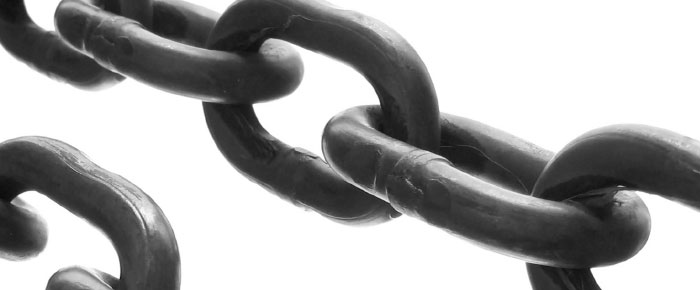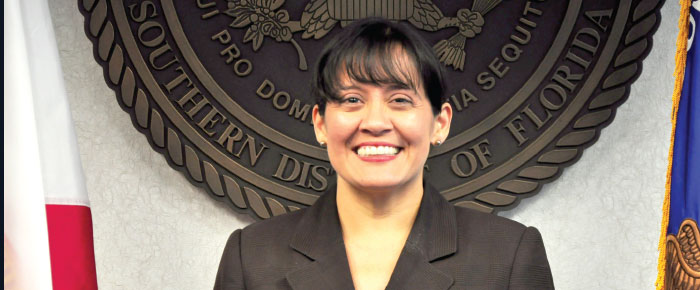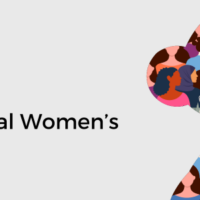
ACAMS Today spoke with Tonja Marshall, supervisory special agent with the Department of Homeland Security, Homeland Security Investigations; Barbara Martinez, assistant United States attorney, chief of the Special Prosecutions Section in the Miami United States Attorney’s Office; and Mr. Carmen Pino, assistant special agent in charge of Human Trafficking Group and South Florida Human Trafficking Task Force Department of Homeland Security, Homeland Security Investigations to discuss the important topic of Human Trafficking (HT) prevention.
Tonja Marshall is a supervisory special agent with the Department of Homeland Security, Homeland Security Investigations, based in Miami, Florida. Agent Marshall began her government career in 1983 as a co-op student/intern with the former U.S. Customs Service while attending college. Upon her graduation, she was selected as a Customs special agent stationed in Dallas, Texas. During her 13-year tenure in Dallas, she conducted investigations involving narcotics, financial crimes and child pornography and was selected as the Special Agent of the Year in 1997 by the regional Women in Federal Law Enforcement organization. From 1997 to 2001, Agent Marshall served in the U.S. Customs Headquarters in Washington, D.C. where she was assigned to the Smuggling Investigations Division.

In 2001, she was selected to supervise the Black Market Peso Exchange investigative group in Miami, Florida. In 2004, she was promoted to assistant special agent in charge, Houston, Texas, where she supervised the Financial Investigations Division. In 2008, Agent Marshall returned to Miami when she was selected to supervise the South Florida Human Trafficking Task Force, a collaborative effort between law enforcement, prosecutors, non-governmental organizations, faith based communities and concerned citizens dedicated to disrupting and dismantling human trafficking (HT) organizations while providing services to trafficking victims. In 2012, the Florida Children and Youth Cabinet selected Agent Marshall as their Law Enforcement Official of the Year for her work in combating human trafficking. Agent Marshall currently supervises a financial crimes group that is tasked with protecting the integrity of the U.S. financial infrastructure by looking at the ways that criminal entities earn, move and store the proceeds of their crimes.
Assistant United States Attorney (AUSA) Barbara A. Martinez is currently the chief of the Special Prosecutions Section in the Miami United States Attorney’s Office. In this capacity, AUSA Martinez supervises federal prosecutors who handle cases involving human trafficking, child exploitation, and violent crime cases resulting death or serious bodily injury, which include serial robberies, hostage takings, kidnappings and gang-related activity. AUSA Martinez is also the Human Trafficking Coordinator and the Project Safe Childhood Coordinator (PSC) for the Southern District of Florida. As the District’s Coordinator for these programs, AUSA Martinez is responsible for coordination between non-governmental entities, federal, state, and local law enforcement officers, and prosecutors in the Southern District of Florida who assist in efforts to combat human trafficking and child exploitation. She conducts training courses for law enforcement officers and prosecutors locally and overseas. In addition, she routinely participates in community outreach events and speaks to the public to increase community awareness. She has been a guest speaker at public forums for migrant workers, grade school students, parents, college students, organization and social club members, health professionals, bar association members, and U.S. Embassy employees. Martinez also teaches human trafficking at the University of Miami School of Law as an adjunct professor.

Mr. Carmen J. Pino is currently the assistant special agent in charge (ASAC) of Homeland Security Investigations in Miami, Florida. In his current position he is responsible for all investigations related to violations of the Immigration & Nationality Act as well as servings as the head of the South Florida Human Trafficking Task Force.
ASAC Pino began his law enforcement career in 1995 in Philadelphia with the Drug Enforcement Administration before transferring to the former U.S. Customs Service in 1997. ASAC Pino had accepted varying assignments with Customs in Arizona, New York and at Headquarters in Washington D.C. before being named assistant special agent in charge in Miami.
ACAMS Today: How significant is the human trafficking problem in South Florida?
Carmen Pino: It is large. When you consider South Florida’s geography, population and economy, it is a ripe environment for HT. Regarding sex trafficking, we have a high tourism industry, and when you have a lot of people coming in for large events, such as the Super Bowl or the NBA finals or Ultra, there is going to be a demand. Where there is a demand there is going to be a supply. So we have seen high-end escorts that are being trafficked by organized criminals.
We have also seen wealthy people from foreign countries exploit a maid or housekeeper by keeping them in a room and forcing them to work 17 hours a day with little to no pay. That is modern-day slavery. We are also a huge agricultural producer for most of the country. As the seasons are changing, we are producing tomatoes, lettuce, and other fruits and vegetables. There is a lot of potential for labor trafficking because we have a lot of migrant workers that are coming in year-round. Unfortunately, we might have the same organizations that are engaged in forced labor also forcing girls and women to engage in sex acts for the migrant workers. They may charge the migrant workers anywhere from $20 to $30 to have sex with these females. We have seen minors and adults getting raped 20 times a night and then that victim is moved around every other week.
Those are some of the reasons why we really put a high emphasis on our outreach program. These instances of trafficking are occurring and most people do not recognize this. A lot of people have seen red flag indicators of trafficking but could not identify it as HT. Say for instance you go into a nail salon and every time you go you see the same person. You can go in the morning, later at night, or on the weekend, and that person is always there. You try to have a normal customer relationship with typical interaction but this person does not talk to you. If you try to strike up a conversation they look to someone else to see if there is some sort of permission to respond. Perhaps you may come across someone who seems troubled. But when approached and asked if something is wrong, someone else speaks for them and tells you, “This person doesn’t speak English. If you have an issue, talk to me.”
Indicators for trafficking include someone who is being controlled, someone who does not engage in a normal client relationship, you see them working from morning to noon and then night. This happens a lot, and people do not realize it. When I first arrived in South Florida I was told “You know, there’s not much trafficking here.” Now, when you see the amount of leads that are coming and the amount of cases that we are working on, it is clear that more awareness is out there. The fact is that if you look at the statistics, we are one of the top three areas for HT. So it’s here, it’s happening and we just need people to realize it. If you see something, say something.
AT: How many human trafficking cases has your office prosecuted?
Barbara Martinez: Since 2007, the U.S. Attorney’s Office for the Southern District of Florida has charged approximately 55 HT cases and 90 defendants. These federal HT cases include both labor and sex trafficking. It is important to note that these numbers reflect only cases where the human trafficking statutes were actually charged. The number of federal HT cases charged here in South Florida during this time period is considered high compared to other districts. Still, these numbers certainly do not reflect the breadth of the problem in South Florida. I think we all believe that there are HT situations that are not being identified or reported; therefore, there is much more work to do as a community that will help combat and identify HT.
CP: Yes, that number may seem kind of low; however, there are also times where we may not have all of the statutory requirements in order to charge the federal trafficking law. So, there are both state and local partners who bring quite a bit of tools to our toolbox. For example, if we are not able to charge the actual trafficking violation, we may get them for something else like alien smuggling, visa fraud or drug-related charges. If we do not charge a trafficker, it does not mean that there might not be situations that have indicators of trafficking.
AT: What penalties do human traffickers face in the federal system?
BM: In the federal system, the Trafficking Victims Protection Act (TVPA), which was enacted in 2000, criminalizes human trafficking. The TVPA provides for a maximum imprisonment term of 20 years for forced labor. Sex trafficking violations carry either a 10 or 15 year mandatory minimum and a maximum term of life imprisonment. A 15 year mandatory minimum applies if force, fraud, or coercion was used or if the victim is less than 14 years old. If the victim is between the ages of 14 and 17, a 10 year mandatory minimum applies. The ultimate sentence really depends on the severity of the coercion or force, the number of victims, and a number of other factors. I will say that we have had numerous defendants in South Florida who have been sentenced to life imprisonment for human trafficking.
AT: What approach do you take when working with victims of a human trafficking case?
BM: Definitely a victim-centered approach. The TVPA sets forth a victim-centered approach that begins the moment we encounter a potential victim as well as the beginning of any HT investigation. Protecting victims and providing for their needs is a priority throughout any criminal investigation, prosecution, and even after the case is done. As a federal prosecutor, the victim-centered approach means that there may be times when a victim’s needs may be inconsistent with our prosecution efforts. In fact, we may decide not to prosecute a case if it is in the best interest of the victim. When you are utilizing a victim-centered approach you must first consider whether the victim wants to proceed with prosecution and whether it is in his or her best interest to proceed. A prosecutor working on a HT case must also determine how to provide for the victim’s needs throughout the criminal process. We are not allowed to take victims home with us, provide them with food, clothing or medical services, give them immigration status, or get them a job. Thus, we have to work very closely with and rely on our LE partners, community partners, non-governmental organizations, private entities, and locally based agencies to provide for the victim. We must coordinate with our partners. This can be very challenging; however, any prosecutor who works on human trafficking cases quickly learns that these partnerships are critical to helping the victims.
CP: When we say we take a victim-centered approach, one thing the public needs to realize is that it is not like let us say a drug case or a money laundering case where we allow things to continue on just for the sake of building additional evidence or letting things “rock” per say. If we know that a victim is being victimized or brutalized in any way, we make a rescue at that point. There is no “waiting” or any “Well, we don’t have all of the evidence.” We stop what we are doing, and we make the rescue and then we try to figure out what we have at that point. So, I just wanted the public to know that we will not allow someone to continue to be victimized just for the simple sake of trying to prove a case.
BM: There is no doubt that utilizing a victim-centered approach impacts how LE investigates these cases and how we prosecute HT cases. The decisions that we make throughout the federal criminal process may differ simply because they are what is best for the victim. Many other types of criminal cases do not require LE and prosecutors to utilize this approach. Also, I should add that in the federal system there are a lot of statutory protections for victims’ privacy, especially if they are minors. There is certain information that simply cannot be released to the public. We make significant efforts to seal documents and to really restrict the number of people who obtain the case information. In the federal system, unlike the Florida state court system, our victims are not deposed by the defense before trial. Obviously, this is a huge benefit to the victim.
AT: When you are working with the community, LE and NGO’s, they are all working as advocates for the victims. Does your office have to go through the advocates in order to get information from the victims?
BM: Yes, typically that is the case. The victim advocate plays an important role in assisting us to build rapport with a victim and addressing the victim’s fears and concerns. I will tell you that we often build very good relationships with the victims. If there is a good relationship with the victim, the advocates often trust LE and the prosecutors more, which allows for better coordination. It certainly makes it much easier on all parties when everyone has the best interest of the victim at heart.
AT: What are some of the other types of criminal offenses that are sometimes charged in addition to human trafficking?
BM: Some of the other charges are
- Immigration laws
- Visa fraud
- Labor laws
- Fraud in foreign labor contracting
- Mann Act, Federal prostitution charges
- Racketeer Influenced and Corrupt Organizations (RICO)
- Alien smuggling
- Money laundering
If we cannot charge them with HT, we all have the view that they should be prosecuted for other related crimes, if possible.
CP: Something else to mention is that the money laundering component of our investigation is critical, because in some of our labor and sex trafficking cases if we can identify the assets, we can use that money for restitution for the victims.
AT: How do you investigate human trafficking cases?
CP: A lot of times the cases are brought to our attention from a few different sources. Number one, we can get a referral from one of our partners, whether it is from LE working on a sting operation or something on a local level. We also get referrals from the social service provider or the non-governmental organizations, where they have come in contact with the victim and they will bring that information forward to us. As our outreach has increased over time, the number of tips we are receiving from the public has greatly increased. And we basically look at it from two phases, as we explained earlier we take a victim-centered approach. We have to make a determination: Is there an opportunity to make a rescue, and if there is that is our primary focus at the time. If we don’t know where a victim may be or if we don’t know if someone is being victimized, we will do the standard investigative method that we do whether it be surveillance, witness interviews, things along those lines. Most of them do come in from the public, which shows that our outreach program is gaining momentum and that the public is becoming aware of the issue that is happening in their backyard.
BM: The actual investigations are handled through the federal Minor Vice Task Force and the South Florida Human Trafficking Task Force. These task forces include federal, state, and local law enforcement officers and prosecutors as well as non-governmental organizations, faith based organizations, and local community members.
CP: As head of the South Florida Human Trafficking Task Force, we generally have a multitude of LE representatives and primarily it’s HSI, the U.S Attorney’s office, the FBI, members of the State Department, health and human services, and the Department of Labor. On the state side we have the Broward County sheriff’s, the Miami-Dade police department, to individual smaller police departments — but what is unique is the close relationship we have with our non-governmental organizations and social service providers. We interact with them weekly and sometimes daily. So they know what we are going to be doing (though obviously we have to protect some LE information), but we will tell them “Listen, be prepared we may have one or two victims for you tonight.” There is a lot of logistical planning that goes into a rescue situation. We must be prepared for everything from finding a bed for them to sleep in to getting the victims’ clothes or medical items. In addition to the social service providers, we have a very large church or faith-based community that is a very good advocate for us. They go out to all of the different churches and they increase awareness. So you can imagine how many people go to church every Sunday hearing about the indicators of trafficking — so that is a big thing. We also have a good partnership with Academia. We have St. Thomas University here that we do a lot of interaction with. So when you put all those different factors together and different areas, we are hitting a big group of people and now if we can get the financial community with us too that will be another amazing partner to add to an already very large and very robust trafficking task force.
AT: What are some of the most significant challenges of investigating human trafficking?
CP: The greatest challenge that we had is that the evidence most of the time is our victim. When you have someone that you now have rescued and have gotten them away from this horrible condition that they were in, they may have to relive that through interviews and potentially being on the stand in front of their abuser. So, a lot of the time that is very challenging because we do not want to reinjure that person mentally and have them relive this horrid experience. If we don’t have a victim, sometimes we don’t have a case. So that is why I said … yes we do have a lot of successful prosecutions with the actual trafficking law but many times we may opt to charge a different violation just because we might not want to put that victim on the stand and have them go through the horrors again. We might get them for money laundering or whatever the case may be and both the prosecutors and the NGO work with us on any decision that is made.
BM: First, identifying human trafficking is challenging because most human trafficking victims do not know what trafficking is. Indeed, most victims do not consider themselves victims at all. This means we must rely on much more than just self-reporting to rescue victims of human trafficking. Second, making sure that victims feel safe and that they are willing to trust you enough to explain what really happened is extremely challenging. When first encountered, most victims are initially very fearful of their traffickers and do not want to cause any trouble for them. We work hard to make sure that victims feel safe and to gain a victim’s trust. Third, once we know about their abuse and trauma, we have to ensure that victims’ needs are met. A victim will typically have many physical, emotional, and personal needs. Making sure that the right people are contacted and that the resources are available is challenging. Fourth, obtaining corroboration of a victim’s statements is sometimes challenging because there is a lack of witnesses or records. This is one reason why investigating the money angle is so helpful. Evidence of money laundering or huge profits by the traffickers helps to corroborate the allegations of human trafficking and to reveal the full picture to a jury. Finally, coordinating with all of our partners and ensuring that the victim is taken care of throughout the prosecution is always challenging.
AT: In what industries have you found victims of human trafficking?
CP: We have seen HT in the
- Sex Industry (escort services, strip joints, brothels, massage parlors)
- Salons
- Agriculture, forestry, fishing industry
- Hospitality Services (restaurants, hotels)
- Construction work
- Landscaping work
- Small business
- Factory work
- Domestic servitude
In fact we had a large landscaping case in Boca Raton where 20 Filipino workers were forced to work in horrid, slave-like conditions for many hours. If there is a need for labor, there are going to be traffickers out there that are going to put those people in those positions.
AT: How often do human traffickers utilize the financial sector?
Tonja Marshall: As far as using the financial sector, I would say about 99 percent of the cases that we see do use the financial sector, whether it is through MSBs or whether it is through the typical financial institution where we have bank accounts. Victims are sending money through MSBs back to family members and back to the traffickers, which sometimes we have found are one and the same — the traffickers are family members. We have seen examples of victims who are working what we call the “circuit.” These victims move from city-to-city and are using MSBs to send money back to the traffickers here in the U.S. and internationally by making deposits into the traffickers’ bank accounts using ATMs.
AT: What are the benefits of investigating the financial aspects of human trafficking?
TM: For me, it is following the money when it comes to trafficking or any type of case. The more records we have, the easier we can identify an organization as a whole. By actually following the documents that are being produced as they move their money, we can identify the organization. You can also find out about other players that are involved, this could lead to potential arrests and prosecutions. This will help us gain more information about the criminal leaders and their organizations. This is one of the greatest benefits of looking at the money. As for HT, I believe that restitution for the victims is important, as Carmen mentioned. And even though it is written in the federal TVPA, we do not always see people or investigators using that tool. Fortunately, we have been very successful in South Florida using the restitution tool and being able to show what wages are owed to the labor and sex trafficking victims. In the Mexican sex trafficking case there was eight or 10 sex trafficking victims that were awarded over 1.2 million dollars in restitution.
AT: You said “investigators do not always use the tool of restitution” even though we are using it here in South Florida, why are investigators not using the tool of restitution? Is it a lack of resources? Where does the money go if it is not being used for the victims?
TM: We see restitution being awarded to victims now more than ever. In the beginning we were not as focused on restitution, but more on making sure that the victim received the services they needed and that the traffickers were being prosecuted — it is a big undertaking to do all of this when dealing with victims. Dealing with a human being’s case is a lot different than dealing with a products case, but I do believe we are doing it more now. Furthermore, a lot of times getting our hands on the assets is extremely difficult. We do have a lot of cooperation with foreign countries in trying to identify assets and in sharing some of the assets with victims. But as far as the restitution, a lot of times it is very difficult to track where the money goes. It is a lot easier to track the larger organized crime organizations because we can see where they use and put the profits back into the organization. As for the less organized trafficking groups or organizations, sometimes we are not able to see the assets that come from the money that they are making.
AT: So, in other words we like to capture the well-organized. I am joking, we prefer to capture everyone.
TM: [Laughs] Well, I will say I have done both, but with the cooperation of law enforcement and foreign prosecutors, a lot of times we see the family is actually the organization and we go back to the foreign country where the family lives and what we see is that they are building another floor onto their house. That is where the proceeds of the client are going, because none of these family members have a job. They have been living off the wages of the trafficking victim. They are not driving the fancy cars that you might think; however, we do see how they are living a more lucrative life than others based on the fact that the trafficking victim is a spouse or a girlfriend of one of the family members and she is here in the U.S. as a trafficking victim.
CP: To complement what Tonja is saying: The more sophisticated the organization is, sometimes it is easier for us to follow the money trail. For example, if you are working a trafficking labor case and the traffickers or business is filing taxes, they have payroll — you essentially have things you can follow. If it is a high-end escort service where they are running a prostitution ring via a website you are seeing all sorts of traffic via email. So there are documents or something else where you can follow the money trail. Especially for our Mexico, Central or South American victims where they are moved around from brothel to brothel, it is a very small cash business. It is 20 or 30 dollars per trip. Also, a lot of times that money is either taken to an MSB or sometimes bulked out. The more sophisticated the organization is — especially if it is a labor trafficking and dealing with legitimate business — the easier it is for us to track the illicit funds.
AT: Is there anything financial institutions can do to help with your investigations?
BM: We are now seeing that the financial industry is becoming a great source of information at the beginning of an investigation for targeting HT. Thus, suspicious activity reports (SARs) can lead us to these HT organizations.
TM: Financial institutions should keep doing the same thing that they are already doing, which is to look for anomalies in account activity that does not follow what they stated the account or business was for. Typically, large cash deposits in a personal account, especially if they are being made by a third party. We see this a lot and it is typically a place where a victim is making deposits into the traffickers account. A lot of these cases have similar characteristics as far as the red flags you look for in the actual bank accounts in financial institutions. For instance, for our sex trafficking cases, when it comes to making cash deposits, it will typically be less than $10,000. Depending if it is a high-end escort versus the Mexico or South American brothel, the amounts will vary, but they are always less than $10,000. Sometimes we contact MSBs because MSBs usually develop a personal relationship with their customers and there are other things they can look for as far as if the person making the deposit is being controlled by another person.
AT: What has your agency done to increase global partnerships to combat human trafficking?
TM: When it comes to trafficking and the financial sector, the idea that we are talking about HT at conferences such as the ACAMS conferences is amazing! Because, I do not think everyone thinks about the asset or financial side of trafficking, but continuing to reach out through these types of partnerships that we have both within the U.S. and internationally is important. I have always been an advocate of talking, talking and more talking. The more we talk about it the more we learn. When I started doing this we were looking at very small cash deposits for MSBs, and as it has progressed we have learned more and more about how trafficking organizations, whether they are large or small, change and adapt to what LE is doing and what we are looking at. Continuing to talk amongst the public and private sectors — again both domestically and internationally — is very important.
A couple of years ago, I attended a working group that my agency sponsored in Washington D.C., where we sat down with heads of AML and compliance for major financial institutions here in the U.S. and we talked about HT and smuggling. We discussed closed investigations with them and shared what we saw and it was an amazing and eye opening experience for both sides on how we can partner up and continue our talks.
AT: Where can members go to report HT or to get more information?
CP: Our primary focus has been on investigating and promoting HT and human smuggling awareness, but we are putting together a website. In the meantime, people can go to the Department of Homeland Security’s Blue Campaign, the U.S. Attorney’s office has links and red flag indicators and our agency, www.ice.gov also has a multitude of information and red flag indicators.
TM: I am sure you’re familiar with project STAMP and Operation Cornerstone and I know that a lot of the financial institutions reach out to our office regarding operation Cornerstone presentations. I had someone call us asking for specific things such as “Can you tell us about HT and the indicators of what we can look for?” So that can be incorporated in a Cornerstone outreach for any financial institution that is interested.
Suspected Human Trafficking in South Florida may be reported to the National Human Trafficking Hotline: 1-888-373-7888.










